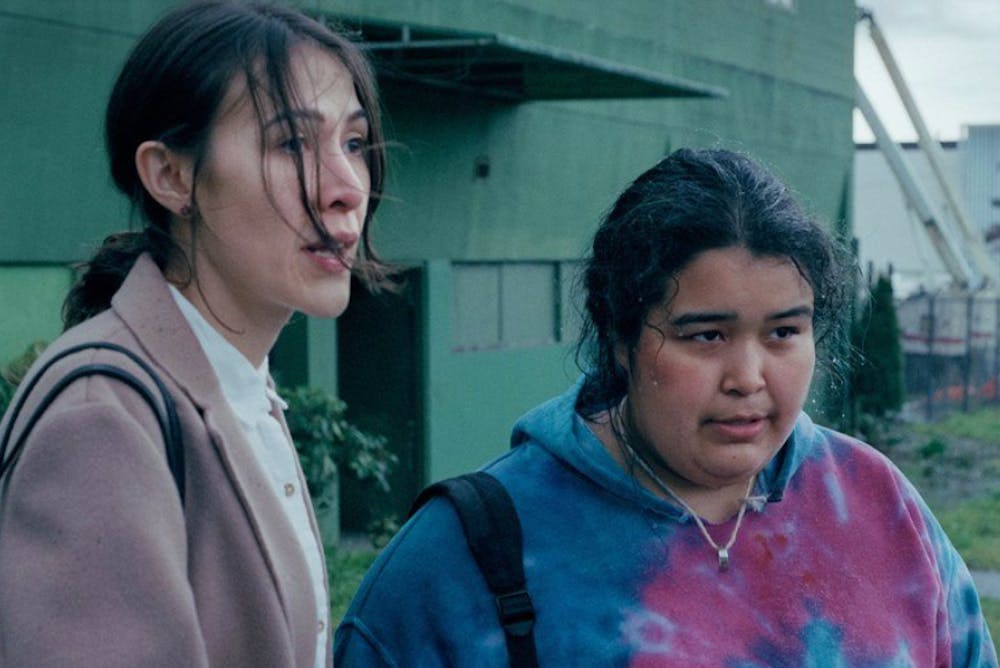The Body Remembers When the World Broke Open follows two Native American women: one in an abusive relationship and one in a healthy relationship. The film parallels their situations early on. Rosie (Violet Nelson) is pregnant with a baby that her abuser doesn’t want her to have. Áila (Elle-Máijá Tailfeathers), meanwhile, is seeking an IUD, despite her boyfriend’s wish for them to have children.
When their paths cross, Áila does everything in her power to offer Rosie a way to escape her situation. However, their dynamic is strained by Rosie’s skepticism and maltreatment-based trauma.
The title of the film, The Body Remembers When the World Broke Open, instantly draws the eye to its length. It is also filled with enough existentially charged words for the phrase to mean any number of things: the Body (a specific person, or more vaguely, humans), remembering (suggests reflection, consideration of the past), the world (a broad, all-encompassing term that could mean anything from a house to the planet), and broke open (implies something like the destruction of a lock, or alternatively, the heavens opening up from above).
The real meaning is never explicitly explained. But, in making the title so intriguing, the film starts off with a layer of depth to foreshadow its gritty, real-time sequence of events.
Along with acting in the lead role, Elle-Máijá Tailfeathers also co-wrote and co-directed the film alongside filmmaker Kathleen Hepburn. Tailfeathers is of Blackfoot and Sámi descent. Her on-screen counterpart, Violet Nelson, is Kwakwaka’wakw and Honduran.
Despite the story not taking place on a reservation, the duo’s shared identity of being native links them intrinsically. The mostly one-take, real-time pace is enhanced by the chilly Vancouver setting.
Although Áila is, without contest, doing the right thing for Rosie, it’s very easy to empathize with Rosie’s perception of Áila’s privilege. In reference to Áila’s boyfriend, who is native but white-passing, Rosie muses, “everybody’s native these days, eh?”
Rosie has been put through the ringer of physical and emotional abuse, and her attitudes reflect a combination of fear and desensitization. Once Rosie finally opens up about the kind of treatment she receives in her home, her tone is casual.
She boomerangs between a place of fear and a place of mocking. Her abuser is the biggest danger in her life, but she is unable to accept kindness that might help her escape it.
The film is written with authenticity as its primary goal, which is further amplified by its one-take format, resulting in a good deal of quiet moments and just walking around. If the viewer isn’t listening intently, that aspect of the film might be perceived as boring. However, it should be argued that the silence is just as crucial as the dialogue.
Each time Áila or Rosie make a conscious effort not to respond to the other or continue on the conversation, the balance of power shifts. Rosie, perhaps in order to feel strong, is dismissive of Áila, and Áila has to choose whether or not to defend herself. People can only get help if they want it.
In the midst of the back-and-forth between the two women, the bigger issue at hand is the cycle of abuse. Is Rosie’s fear of her abuser stronger than her desire to improve herself? Relationships built on the foundation of ill treatment result in low self-esteem as a way to justify the abuse.
Of course, the domestic violence that Rosie has tolerated time and time again is now ingrained into her sense of self-worth. Rosie remarks that her abuser’s mother, whose home they live in, is afraid of him, too. If she can’t trust anyone she lives with, why should she trust a stranger?
The Body Remembers When the World Broke Open is a bleak tale. It offers no real solutions on how to help people escape from toxic relationships. But its story is essential, simply by lending itself to a larger conversation about domestic abuse. The truth of the matter creates broader empathy for people who are unable to help themselves.






